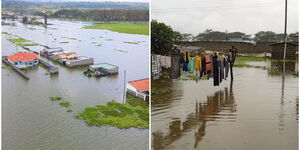Every rainy cycle, families across the country stock up on cold weather gear including gumboots and jumpers to keep warm and shield their clothing from mud stains.
Over the years, however, many Kenyans, especially those residing in areas with poor infrastructure and dilapidated drainage systems, struggle to keep their gumboots clean.
In light of this, Nairobi residents are increasingly turning to portable waterproof shoe covers ahead of El Nino rains, expected to kick in the second week of October.
Valued between Ksh2,000 and Ksh10,000, these shoe covers come in a range of waterproof materials, from plastic to silicone-based options.
Residents who have purchased the special gear find it easy to use. They simply put on their shoes and then wear the covers, allowing them to carry out their tasks without worrying about getting soaked in water and mud.
They are also foldable and easy to clean compared to gumboots.
Material Range
The high-end products in this range are crafted from top-quality waterproof PVC material, ensuring seamless integration and superior waterproofing.
This reliable protection keeps expensive shoes underneath both dry and clean, guarding against not only water but also oil and dust.
Additionally, these products come with anti-skid features, enhancing their practicality and safety. Amazon values these premium items at over Ksh5,000.
On the other hand, the more affordable version is constructed from clear, thicker polyethylene bags that are not only reusable but also resistant to both dust and water.
Importance of the Shoe Covers
Portable waterproof shoe covers can be worn both indoors and outdoors. They are ideal for wet surfaces because they are built to be anti-slip.
Away from rainy situations, the covers come in handy in sterile environments such as operating theaters to protect wearers from contamination and coming into contact with bodily fluids.
El Nino
Kenyans have been on the edge for the last couple of months after the forecast indicated that the El Nino phenomenon, whose effects were dire in 1998, was expected from the second week of October.
The Kenya Meteorological Department indicated that above-average rainfall is expected in most parts of the country during the October to December long rain season. In Western, the effects may spill over to January 2024.
"We have given the forecast, the El Nino is with us, and the story about there being no El Nino and rainfall just being enhanced, there is misinformation somewhere," noted the department's Director David Gikungu.
El Nino is a climate pattern originating from the Pacific Ocean running along the Equator. It is accompanied by rising seas and increased temperatures
Areas expected to see increased rainfall include Highlands West of the Rift Valley, the Lake Victoria Basin, Central, and Southern Rift Valley among others.
Nairobi plans to move residents living in lowland areas to higher grounds.












